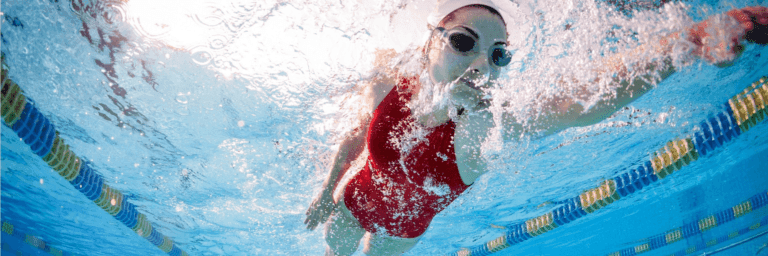Swimming is a popular activity for fitness and pleasure in the UK, but it can also lead to injuries if proper precautions are not taken. According to the Royal Society for the Prevention of Accidents (RoSPA), around 30,000 swimming-related injuries are treated in UK hospitals each year.
Many of these injuries could have been prevented by observing some simple safety precautions. Whether you swim for fitness or leisure, here are some tips to help ensure your time in the water is as safe and enjoyable as possible.
General Guidelines
- Learn to Swim and Never Swim Alone
- Continuously swim in supervised areas where lifeguards are present.
- Inexperienced swimmers should wear life jackets in the water.
- Swimming alone is dangerous, regardless of your skill level. Always have a buddy.
- Know Your Limits
- Only attempt to swim if you are well-rested, calm, and overheated.
- Be aware of your physical condition and avoid overexertion.
- Open Water Safety
- Never run and dive headfirst into waves.
- Ensure the water is free of undercurrents and other hazards.
- Avoid swimming in lakes or rivers after storms or during flooding, as currents can be strong, and water clarity and depth can change.
- Check Weather Conditions
- Always check the weather report before going swimming.
- Avoid swimming during storms, fog, or high winds. Water conducts electricity, making it extremely dangerous during an electrical storm.
- Avoid Alcohol
- Alcohol impairs judgement, slows movement, and affects vision, making swimming risky.
- It also reduces swimming skills and makes it harder to stay warm.
- First Aid Knowledge
- Be knowledgeable about first aid to handle minor injuries such as cuts, bruises, or sprains.
- Be prepared for emergencies and have a plan to reach medical personnel for severe injuries like concussions, dislocations, or fractures.
- Prevent Swimmer’s Ear
- Dry your ear canals with a cotton tip after swimming to prevent infections.
Diving Safety
Diving can be hazardous if not done correctly. More than 1,900 spinal cord injuries from diving accidents occur every year, many resulting in paralysis. Here are some essential tips to avoid injury:
- Dive Safely
- Never dive in shallow water.
- Avoid diving into murky water; you should be able to see the bottom of the pool.
- Check the shape and depth of the diving area to ensure it is safe.
- Use Diving Boards Correctly
- Dive only off the end of a diving board.
- Do not run on the board; try to dive far out or bounce more than once.
- Swim away from the board immediately after diving to make room for the next person.
- Ensure only one person uses the diving board at a time.
Swimming for Fitness
Swimming is an excellent way to build endurance and strength while protecting your bones and joints from high-impact exercises. However, improper technique or lack of preparation can lead to injuries. Follow these tips to swim safely:
- Warm Up and Stretch
- Always warm up with activities like jumping jacks, stationary cycling, or running in place for 5 to 10 minutes.
- Stretch slowly and gently, holding each stretch for 30 seconds. Cold muscles are more prone to injury.
- Prevent Shoulder Injuries
- Shoulder pain is the most common swimming injury due to repetitive motion.
- Engage in a general exercise program to strengthen the muscles around your shoulders and upper back.
- Swim When Healthy
- Avoid vigorous swimming if you have a fever, upper respiratory infection, or ear infection.
Checklist for Pool Safety
To ensure your pool is safe for everyone, consider the following questions:
- Safety Features
- Are there depth indicators visible around the pool?
- Is the pool and surrounding area well-lighted during use?
- Supervision and Rules
- Do you ensure guests never swim alone?
- Do you prevent guests from swimming if they have consumed alcohol or drugs?
- Do you enforce set hours for pool use?
- Security and Lifeguards
- Is your pool secured with fencing to prevent unauthorised access?
- Does your pool have a designated diving area?
- Do you have a lifeguard or someone trained in water safety and life-saving techniques present?
Following these guidelines and safety measures can significantly reduce the risk of swimming-related injuries. Ensuring a safe environment will allow you and others to enjoy the many benefits of swimming, whether for fitness or fun. Stay informed, stay prepared, and most importantly, stay safe in the water.






